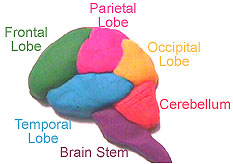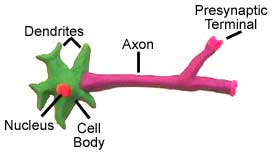11/29 - We will have 4 groups of 5 students. You can make your own groups. Check the science room to see if you can find some of the materials
Group 1: Model of the Brain and its texture
1.5 cups (360 ml) instant potato flakes
2.5 cup (600 ml) hot water
2 cups (480 ml) clean sand
1 gallon ziplock bag
Combine all of the ingredients in the ziplock bag and mix thoroughly. It should weigh about 3 lbs. (1.35 kg.) and have the consistency of a real brain.
Group 2: Model of the Brain - parts of the brain
clay: red; pink; blue, yellow green, purple
Create a model of the brain by using clay, playdough, styrofoam, recyclables, food, etc. Create a whole brain or use a brain atlas and create cross-sections of the brain at different levels. Use different colors to indicate different structures.


Materials:
Clay or Playdough or Styrofoam or Recyclables (bottle caps, cups, buttons, etc) OR Food (fruit, jelly beans)
A picture or diagram of the brain
33 empty spools of thread OR buttons may also work OR slices of paper towel holders).
Long strings or yarn
The human spinal cord is protected by the bony spinal column shown. There are 31 segments of the spinal cord and 33 bones (vertebrae) that surround these segments. There are 7 cervical vertebrae, 12 thoracic, 5 lumbar, 5 sacral and 4 coccygeal vertebrae in the human body. To model these bones, get 33 empty spools of thread (buttons may also work or slices of paper towel holders). Run a string or thread through the middle of one of the spools or buttons. Tie off one end of the string and put the remaining spools or buttons on the string. Each spool (or button) will represent one vertebra. When your model is finished, notice how it can bend. In a real spinal column, the vertebrae are held together by ligaments.
Materials:
Empty thread spools or buttons
String
Create a model of the brain by using clay, playdough, styrofoam, recyclables, food, etc. Create a whole brain or use a brain atlas and create cross-sections of the brain at different levels. Use different colors to indicate different structures.


Materials:
Clay or Playdough or Styrofoam or Recyclables (bottle caps, cups, buttons, etc) OR Food (fruit, jelly beans)
A picture or diagram of the brain
Group 3: Nerve Cell


modeling clay - different colors
Group: 4 - Spinal cord
 |
Long strings or yarn
The human spinal cord is protected by the bony spinal column shown. There are 31 segments of the spinal cord and 33 bones (vertebrae) that surround these segments. There are 7 cervical vertebrae, 12 thoracic, 5 lumbar, 5 sacral and 4 coccygeal vertebrae in the human body. To model these bones, get 33 empty spools of thread (buttons may also work or slices of paper towel holders). Run a string or thread through the middle of one of the spools or buttons. Tie off one end of the string and put the remaining spools or buttons on the string. Each spool (or button) will represent one vertebra. When your model is finished, notice how it can bend. In a real spinal column, the vertebrae are held together by ligaments.
Materials:
Empty thread spools or buttons
String